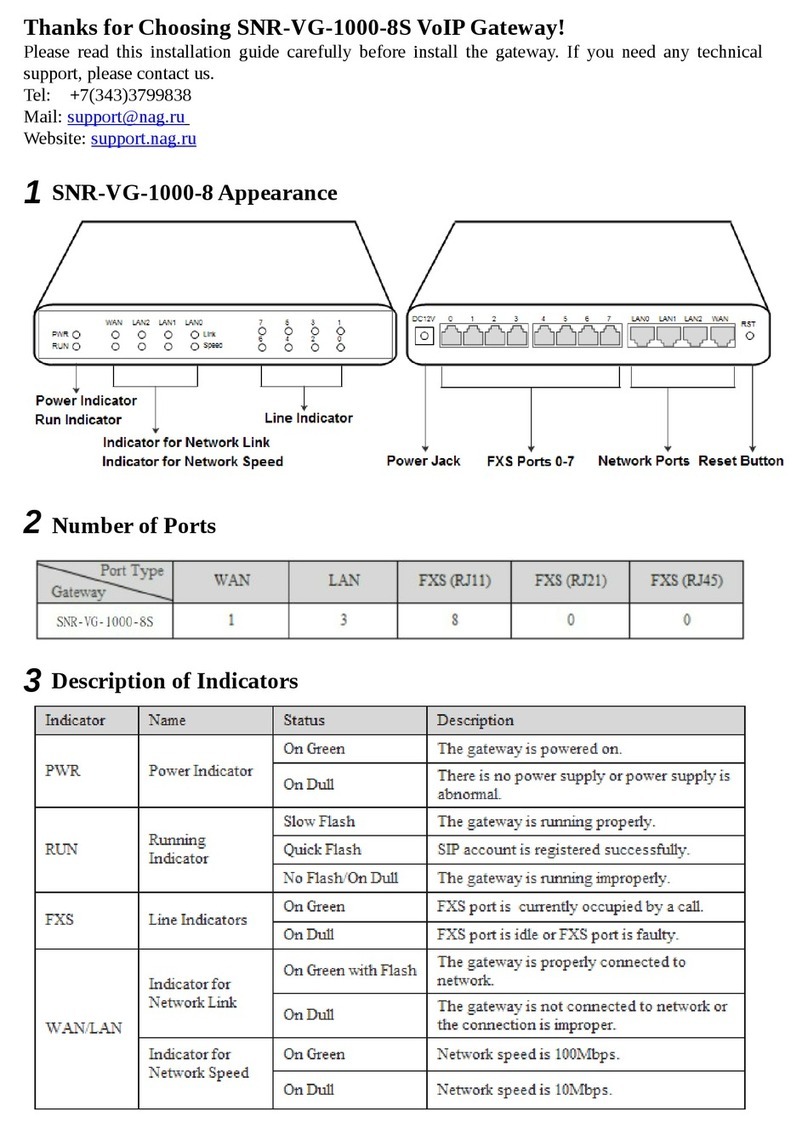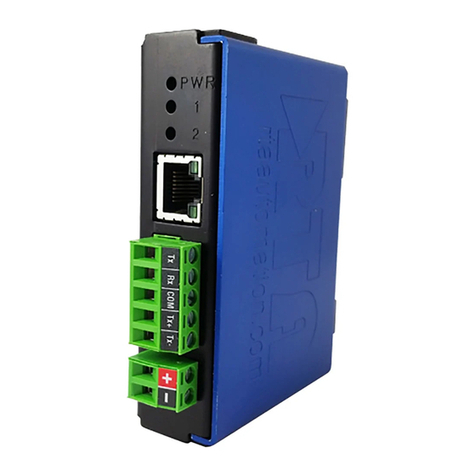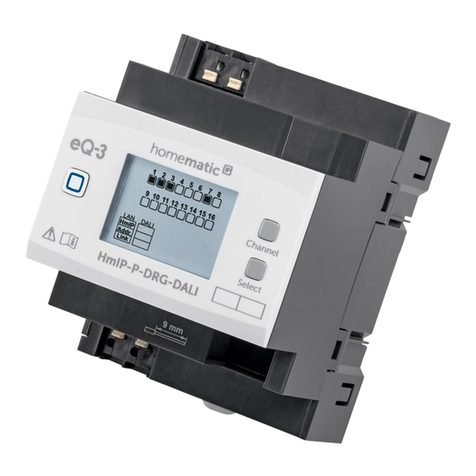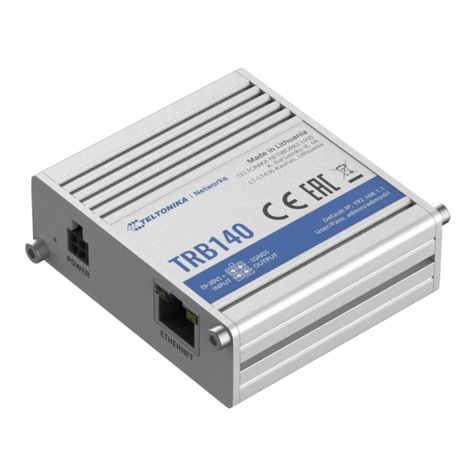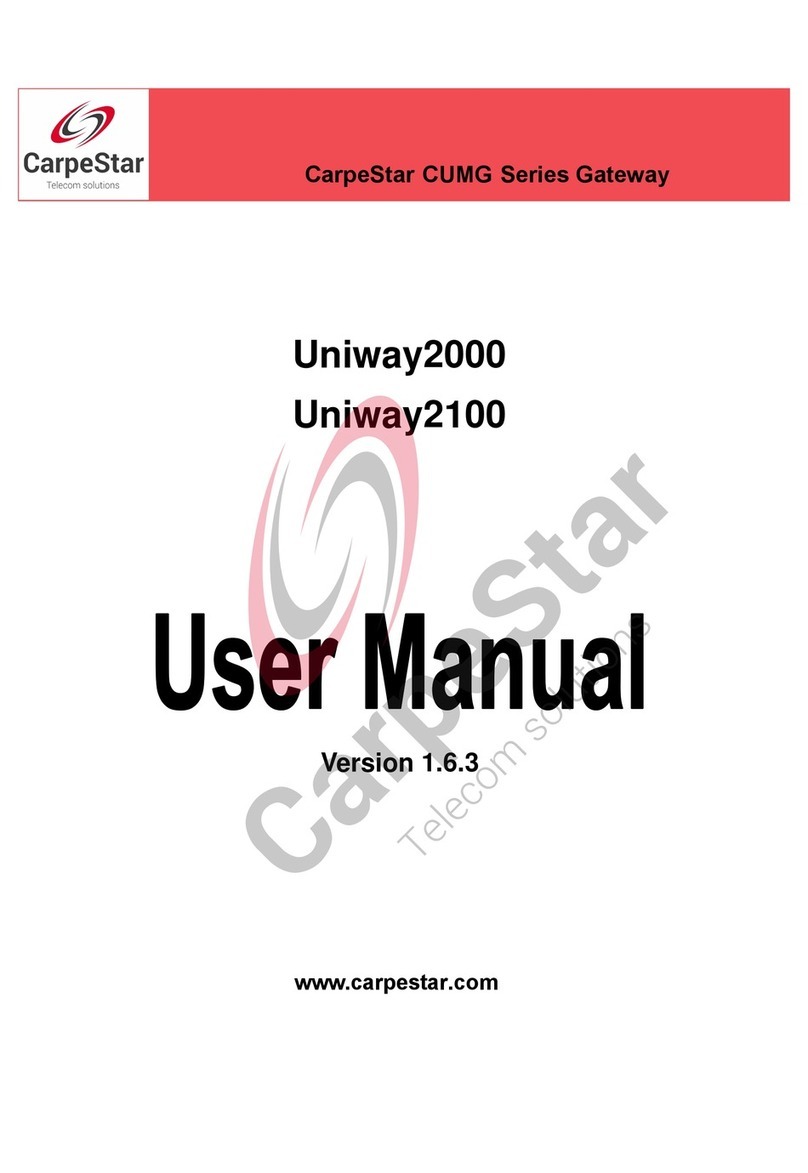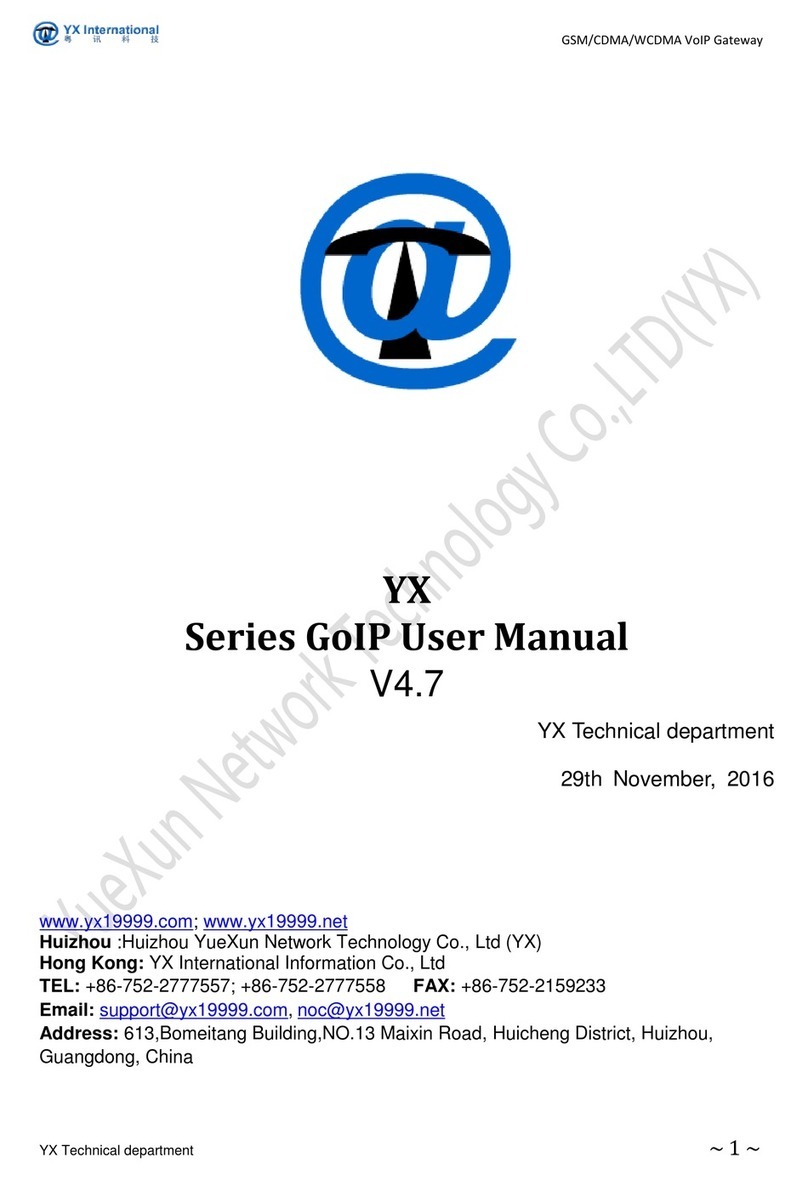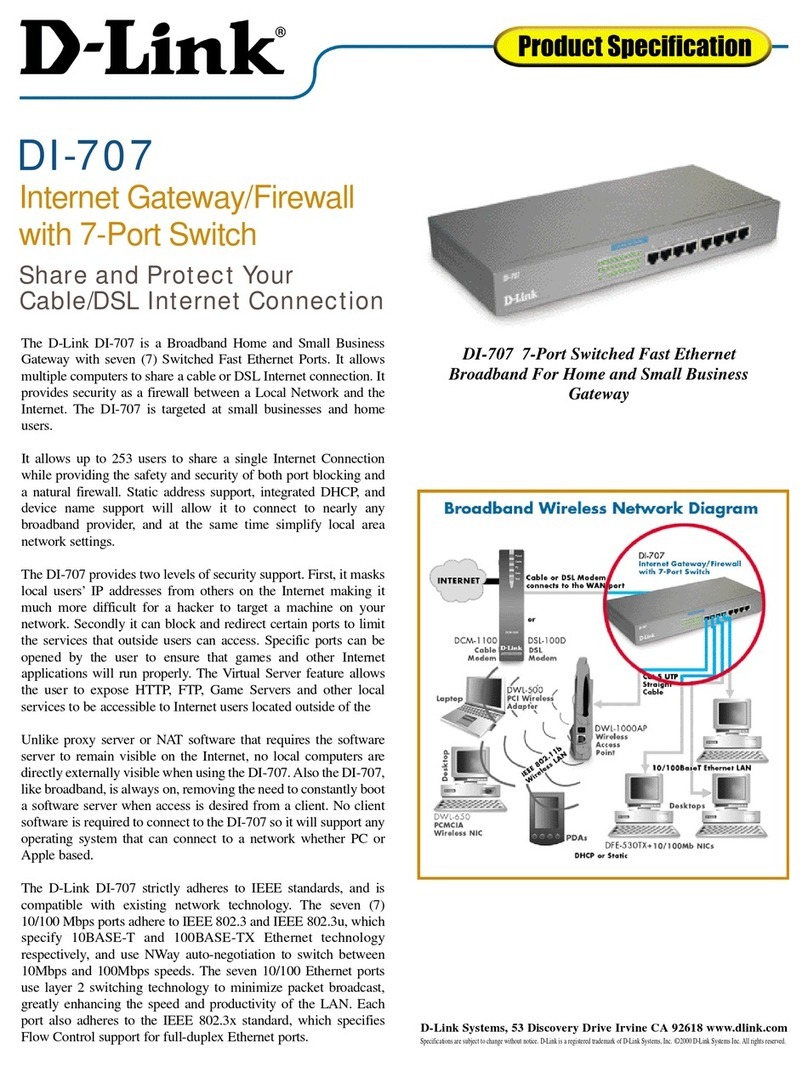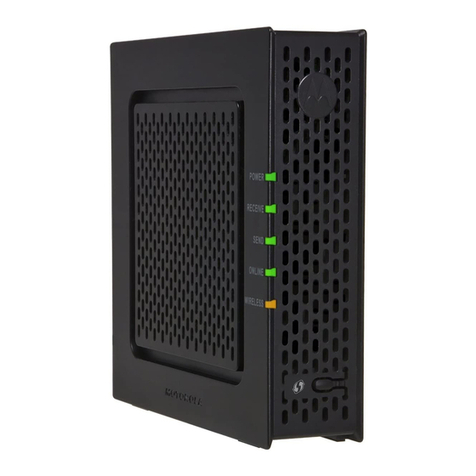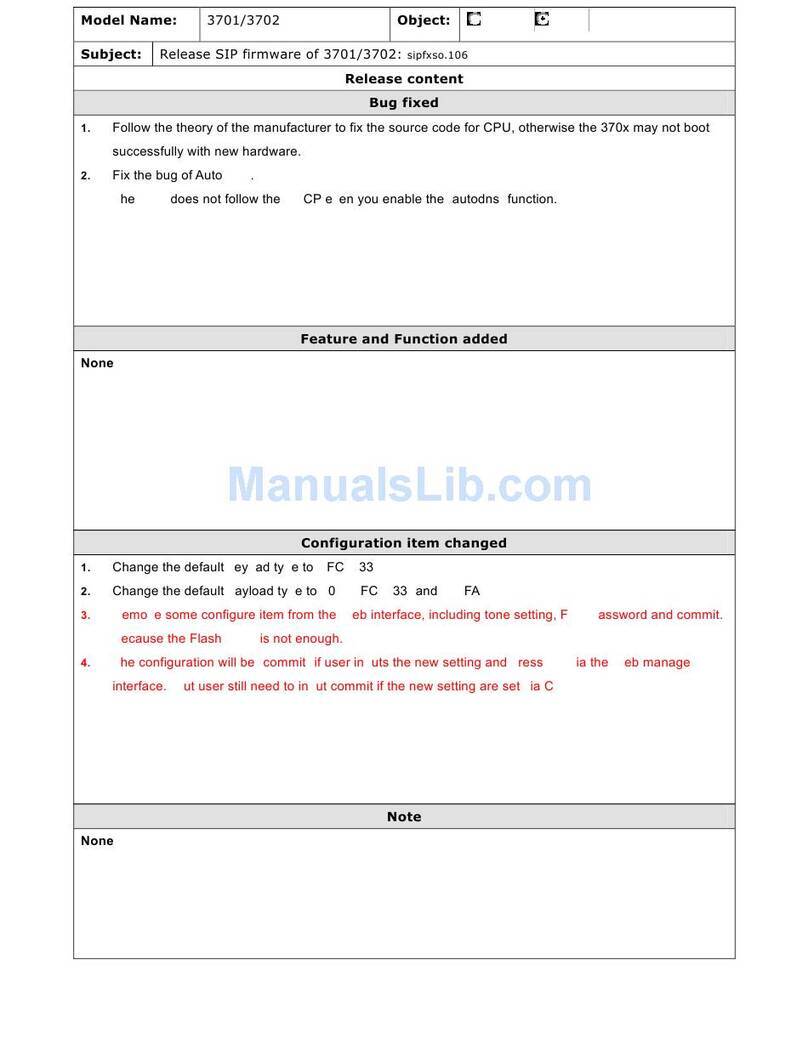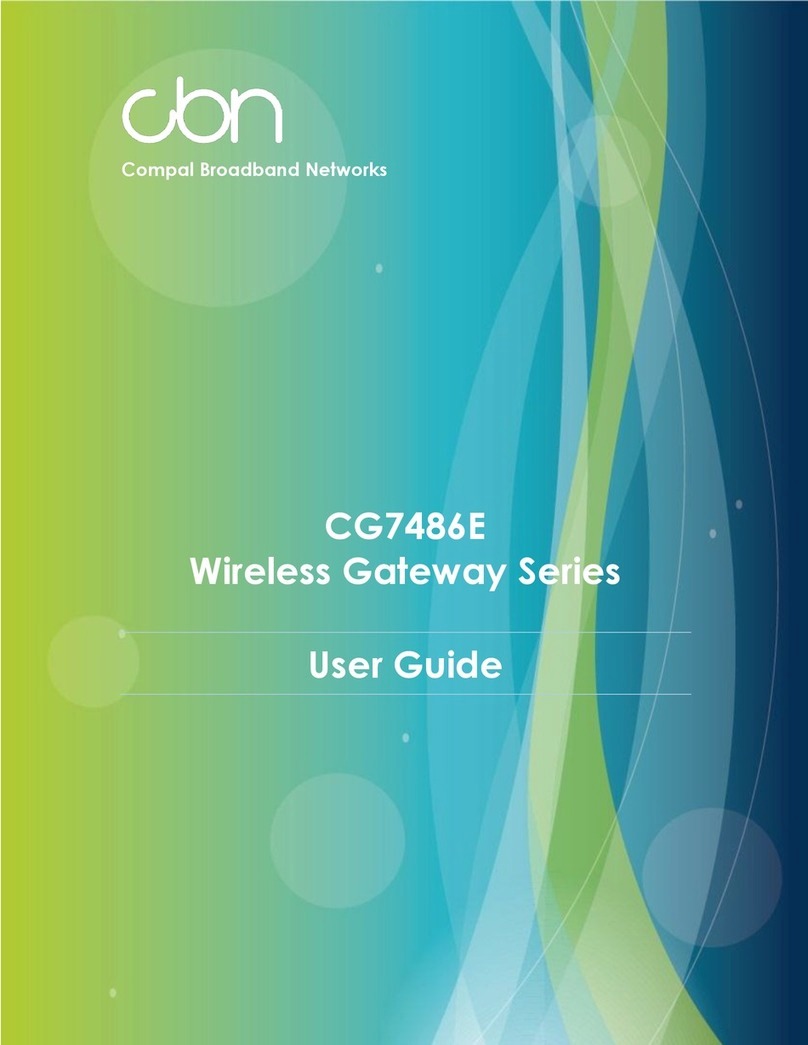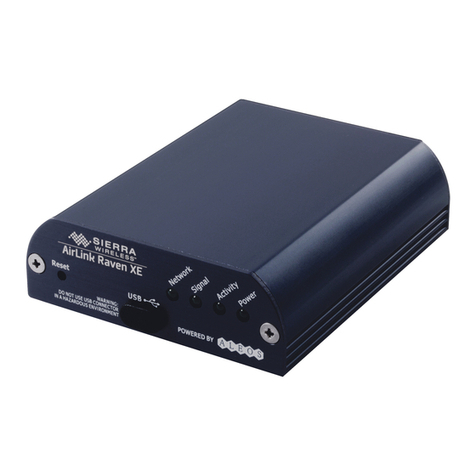SNR SNR-VG-6040 User manual

User Manual
SNR-VG-60X0
Analog IP Gateway
4 or 8 FXO Ports
NAG LLC

SNR-VG-6040 User Manual
Copyright © 2012 NAG LLC Page 2 of 25
Table of Content
1WELCOME...................................................................................................................3
1.1 Gateway SNR-VG-60x0 Overview ..................................................................3
1.2 Safety Compliances.........................................................................................3
1.3 Warranty...........................................................................................................4
2PACKAGING................................................................................................................4
2.1 Connect The SNR-VG-60x0............................................................................4
3APPLICATION DESCRIPTION....................................................................................6
3.1 Functional Diagram of IP-PBX & SNR-VG-60x0.............................................6
3.2 SNR-VG-600x&SNR-VG-60x0 Scenario/Toll- Free Calling Between Locations
7
4FEATURES...................................................................................................................7
4.1 Software Features Overview ...........................................................................7
4.2 Hardware Specification....................................................................................9
5CONFIGURATION GUIDE...........................................................................................9
5.1 Configuration With Web Browser ....................................................................9
5.1.1 Accessing The Web Configuration Menu...............................................9
5.2 End User Configuration .................................................................................10
5.2.1 Status Page Definitions ........................................................................10
5.2.2 Basic Settings Page..............................................................................11
5.3 Super User Settings.......................................................................................12
5.3.1 Super Configuration Page Definitions..................................................12
5.3.2 Profiles..................................................................................................14
5.3.3 Configuring The FXO Channels ...........................................................21
5.4 Saving The Configuration Changes...............................................................23
5.5 Rebooting From Remote ...............................................................................23
6FIRMWARE UPGRADE.............................................................................................24
7RESTORE FACTORY DEFAULT SETTINGS............................................................25
8TECHNICAL SUPPORT CONTACT..........................................................................25

SNR-VG-6040 User Manual
Copyright © 2012 NAG LLC Page 3 of 25
1 WELCOME
Thank you for purchasing the SNR SNR-VG-60x0 IP Analog FXO Gateway. The
SNR-VG-60x0 is a cost effective, easy to use and easy to configure IP communications
solution for any business. The SNR-VG-60x0 supports popular voice Codecs and is
designed for full SIP compatibility and interoperability with 3rd party SIP providers, thus
enabling you to fully leverage the benefits of VoIP technology, integrate a traditional phone
system into a VoIP network, and efficiently manages communication costs.
This manual will help you learn how to operate and manage your SNR-VG-60x0 Analog IP
Gateway and make the best use of its many upgraded features including simple and quick
installation, multi-party conferencing, etc. This IP Analog Gateway is very easy to manage
and scalable, specifically designed to be an easy to use and affordable VoIP solution for
the small –medium business or enterprise.
1.1 Gateway SNR-VG-60x0 Overview
The SNR-VG-60x0 offers an easy to manage, feature rich IP communications solution for
any small business or businesses with virtual and/or branch locations who want to
leverage their broadband network and/or add new IP Technology to their current phone
system. The SNR Enterprise Analog VoIP Gateway SNR-VG-60x0 series converts
SIP/RTP IP calls to traditional PSTN calls and vice versa. There are two models - the
SNR-VG-6040 and SNR-VG-6080, which have either 4 or 8 FXO ports respectively. The
installation is the same for either model.
Caution: Changes or modifications to this product not expressly approved by SNR
Technology, or operation of this product in any way other than as detailed by this User
Manual, could void your manufacturer warranty.
Information in this document is subject to change without notice. No part of this document
may be reproduced or transmitted in any form or by any means, electronic or mechanical,
for any purpose without the express written permission of SNR Technology.
1.2 Safety Compliances
The SNR-VG-60x0 is compliant with various safety standards including FCC/CE. Its
power adaptor is compliant with UL standard.
Warning: use only the power adapter included in the SNR-VG-60x0 package. Using an
alternative power adapter may permanently damage the unit.

SNR-VG-6040 User Manual
Copyright © 2012 NAG LLC Page 4 of 25
1.3 Warranty
SNR has a reseller agreement with our reseller customer. End users should contact the
company from whom you purchased the product for replacement, repair or refund.
If you purchased the product directly from SNR, contact your SNR Sales and Service
Representative for a RMA (Return Materials Authorization) number. SNR reserves the
right to remedy warranty policy without prior notification.
2 PACKAGING
Unpack and check all accessories. The SNR-VG-60x0 package contains:
One SNR-VG-60x0 VoIP adapter
One universal power supply
One Ethernet cable
2.1 Connect The SNR-VG-60x0
Managing the SNR-VG-60x0 gateway and connecting the unit to the VoIP network is very
simple. Follow these four (4) steps to connect your SNR-VG-60x0 gateway to the Internet
and access the unit’s configuration pages.
1. Connect PSTN Line to the FXO1-FXO8 ports.
2. Insert the Ethernet cable into the WAN port of SNR-VG-60x0 and connect the other end
of the Ethernet cable to an uplink port (a router or a modem, etc.)
3. Connect a PC to the LAN port of SNR-VG-60x0 for initial configuration or if it is being
used as a router.
4. Plug the power adapter into the SNR-VG-60x0 and into a power outlet.
Figure 1: Diagram of SNR-VG-60x0 Back Panel

SNR-VG-6040 User Manual
Copyright © 2012 NAG LLC Page 5 of 25
TABLE 1: Definitions Of The SNR-VG-Connectors
LAN (or PC)
Connect your PC to this port. It will then be assigned an
IP address from your Router/DHCP Server. The
SNR-VG-60x0 acts as a switch only.
WAN (or LAN)
Connect to the internal LAN network or Public Internet.
RESET
Factory Reset button. Press for 7 seconds to reset
factory default settings.
POWER IN
Power adapter connection
FXO1 - FXO8
FXO ports to be connected to physical PSTN lines from
a traditional PSTN PBX or PSTN Central Office.
Figure 2: Diagram Of SNR-VG-60x0 Display Panel
TABLE 2: Definitions Of The SNR-VG-Display Panel
Power LED
Indicates Power.
Remains ON when Power is connected and turned ON.
Ready LED
Remains ON after boot-up.
LAN LED
Indicates LAN (or WAN) port activity
WAN LED
Indicates PC (or LAN) port activity
LEDs 1 - 8
Indicate status of the respective FXO Ports on the back
panel
Busy - ON
Available - OFF.
NOTE:
All LEDs display green when ON.
During a firmware upgrade or configuration download the following LED pattern will be
observed:
Power, WAN LEDs will be ON. The RUN LED will keep flashing during download and
while the new files are written. The entire process may take between 5 to 15 minutes. The

SNR-VG-6040 User Manual
Copyright © 2012 NAG LLC Page 6 of 25
firmware upgrade is complete when you can login into the web configuration pages.
3 APPLICATION DESCRIPTION
3.1 Functional Diagram of IP-PBX & SNR-VG-60x0

SNR-VG-6040 User Manual
Copyright © 2012 NAG LLC Page 7 of 25
3.2 SNR-VG-600x&SNR-VG-60x0 Scenario/Toll-
Free Calling Between Locations
4 FEATURES
SNR-VG-60x0 is a next generation IP voice and video gateway that features full
interoperability with leading IP-PBXs, SoftSwitches and SIP platforms. The Gateway
series offers superb voice and video quality, traditional telephony functionality, simple
configuration, feature rich functionality and an additional video port that enables the
gateway to act like a video surveillance gateway.
4.1 Software Features Overview
4 and 8 FXO port gateways

SNR-VG-6040 User Manual
Copyright © 2012 NAG LLC Page 8 of 25
External power supply
Two RJ-45 ports (switched or routed)
TFTP and HTTP firmware upgrade support
Multiple SIP accounts, multiple SIP profiles (choice of 2 profiles per account)
Supports Audio Codecs: G711U/A, G723, G729A/B and GSM
G.168 –echo cancellation
Flexible DTMF transmission: In Audio, RFC2833, SIP Info or any combination of the 3
Selectable, multiple LBR coders per channel
T.38 compliant
TABLE 3: SNR-VG-60x0 Software Features
SNR-VG-60x0 FXO Analog Gateway Series
IP settings
SNR-VG-6040:
4 ports; 4 SIP accounts w/ choice of 3 SIP Server profiles
SNR-VG-6080:
8 ports; 8 SIP accounts w/ choice of 3 SIP Server profiles
Round-robin port scheduling to ensure available lines to
access PSTN networks
Telephone Interfaces
4 or 8 FXO, RJ11
Network Interface
Two (2) 10M/100 Mbps, RJ-45
LED Indicators
Power and Line LEDs
Voice over Packet
Capabilities
G.168 compliant Echo Cancellation, Dynamic Jitter
Buffer, Modem detection & auto-switch to G.711
Voice Compression
G.711U, G711A, G.723, G.729A/B, G.726
DHCP Server/Client
Switch Mode and PPPoE
Fax over IP
T.38 compliant Group 3 Fax Relay up to 14.4kpbs and
auto-switch to G.711 for Fax Pass-through
QoS
Diffserve, TOS, 802.1 P/Q VLAN tagging
IP Transport
RTP/RTCP and RTSP
PSTN Signaling
FXO Loop start, Current Disconnect.
DTMF Method
Flexible DTMF transmission method,
User interface of In-audio, RFC2833, and SIP Info
IP Signaling
SIP (RFC 3261)
Provisioning
TFTP and HTTP
Control
TLS and SIPS (pending)
Management
Syslog support,remote management using Web browser
Short and long haul
REN3: Up to150 ft on 24 AWG line
Caller ID
Bellcore Type 1 & 2, ETSI, BT, NTT, and DTMF-based
CID
Polarity Reversal / Wink
Yes (Detection only). The PSTN lines will need to be
subscribed to PR service from the Service Provider.
EMC
SNR-VG-60x0: EN55022 Class B, CFR Part 15 Class B,

SNR-VG-6040 User Manual
Copyright © 2012 NAG LLC Page 9 of 25
EN55024;
SNR-VG-6040: FCC, CE (in addition)
Safety
SNR-VG-60x0: EN60950-1 SNR-VG-6080: UL60950-1
(in addition)
4.2 Hardware Specification
TABLE 4: Hardware Specification Of SNR-VG-60X0
LAN interface
2xRJ45 10/100Mbps
LED
4 or 8 LEDs (GREEN)
Universal Switching
Power Adaptor
Input: 100-240V AC, 50/60Hz, 0.5A Max
Output: 9V DC, 2A UL certified
Dimension
225mm (L) x 172mm (W) x 42mm (H)
Weight
0.29 lbs (3.5 oz)
Temperature
32~104°F / 0~40°C
Humidity
10% - 90% (non-condensing)
Compliance
FCC, CE
5 CONFIGURATION GUIDE
5.1 Configuration With Web Browser
The SNR-VG-60x0 has an embedded Web server that will respond to HTTP GET/POST
requests. It also has embedded HTML pages that allow a user to configure the gateway
through any common web browser.
5.1.1 Accessing The Web Configuration Menu
The SNR-VG-60x0 HTML configuration menu can be accessed via LAN or WAN port:
From the LAN port:
1. Directly connect a computer to the LAN port.
2. Open a command window on the computer
3. Type in “ipconfig /release”, the IP address etc. becomes 0.
4. Type in “ipconfig /renew”, the computer gets an IP address in 192.168.22.x segment by

SNR-VG-6040 User Manual
Copyright © 2012 NAG LLC Page 10 of 25
default
5. Open a web browser, type in the default gateway IP address. http://192.168.22.1.
You will see the login page of the device.
From the WAN port:
The WAN port HTML configuration option is disabled by default from factory. To access
the HTML configuration menu from the WAN port:
1. Enable the “WAN Port Web Access” option via IVR option 12.
2. Find the WAN IP address of the SNR-VG-60x0 using voice prompt menu option 02.
3. Access the SNR-VG-60x0 Web Configuration page by the following URI via WAN port:
http:// SNR-VG-60x0 -IP-Address (the SNR-VG-60x0 IP-Address is the WAN IP address
for the SNR-VG-60x0).
NOTE: If using a web browser to enter the configuration page, strip the leading “0”s
because the browser will parse in octet. (i.e. if the IP address is: 192.168.001.014, please
type in: 192.168.1.14).
5.2 End User Configuration
Once the HTTP request is entered and sent from a Web browser, the user will see a log in
screen. There are two default passwords for the login page:
User
Password:
Level:
End User Level
1234
Only Status and Basic Settings
Administrator Level
admin
Browse all pages
FIGURE 3: Screen-Shot Of SNR-VG-60x0 Log-In Screen
5.2.1 Status Page Definitions
DEVICE STATUS
Setting Options
Definitions

SNR-VG-6040 User Manual
Copyright © 2012 NAG LLC Page 11 of 25
MAC Address
The device ID, in HEX format. This is a very important ID for
ISP troubleshooting.
WAN IP Address
This field shows IP address of device
Product Model
Show product model of this device
Software Version
Information of software
System Uptime
Show system uptime since last reboot
PPPoE Link Up
Indicates where the PPPoE connection is up if the
Uicorn2101 is connected to the DSL modem.
NAT
Indicate the NAT type behind which the device is when the
stun feature is defined.
Port Status
Indicate the current status of the device such as hook
(on/off),registion(registered/unregistered) etc.
5.2.2 Basic Settings Page
BASIC OPTIONS SETTING
Setting options
Definitions
Web Port
Default is 80.
IP Address
There are 3 modes under which the SNR-VG-600x can
operate:
- If DHCP mode is enabled, then all the field values for the
Static IP mode are not used (even though they are still
saved in the chipset's memory). The SNR-VG-600x will
acquire its IP address from the first DHCP server it
discovers from the office/home network it is connected to.
-To use the PPPoE feature, the PPPoE account settings
need to be set. The SNR-VG-600x will attempt to establish
a PPPoE session if any of the PPPoE fields have been
entered with data.
- If Static IP mode is enabled, then the IP address, Subnet
Mask, Default Router IP address, DNS Server 1 (primary),
DNS Server 2 (secondary) fields will need to be
configured by the user. These fields are reset to zero by
default.
Time Zone
This parameter controls how the displayed date/time will
be adjusted according to the specified time zone.
Allow DHCP Option 2
to override Time Zone
setting
If set yes and under DHCP mode,the device will try to get
option 2 from DHCP configure and overwrite Time Zone.
Daylight Savings Time
This parameter controls whether the displayed time will be
daylight savings time or not. If set to Yes, then the
displayed time will be 1 hour ahead of normal time.

SNR-VG-6040 User Manual
Copyright © 2012 NAG LLC Page 12 of 25
Device Mode
This parameter controls whether the device is working in
NAT router mode or Bridge mode. Need save the setting
and reboot the device before the setting start to work
LAN Subnet Mask
Sets the LAN subnet mask. Default value is 255.255.255.0
LAN DHCP Base IP:
Base IP for the LAN port which functions as a Gateway for
the subnet. Default value is 192.168.22.1
DHCP IP Lease Time:
Value is set in units of hours. Default value is 120hr (5
Days) The time IP address are assigned to the LAN clients
Port Map
Forwards a matching (TCP/UDP) port to a specific LAN IP
address with a specific (TCP/UDP) port
End User Password
This contains the password to access the Web
Configuration Menu. This field is case sensitive.
Reply to ICMP on WAN
port
If set to “Yes”, the SNR-VG-600x will respond to the PING
command from other computers, but it also is vulnerable
to the DOS attack. Default is No.
Wan Side Http Access
If this parameter is set to “No”, the HTML configuration
update via WAN port is disabled.
5.3 Super User Settings
The end-user needs to login to the Super user configuration page the same way as for the
basic configuration page.
FIGURE 4: Screenshot Of Super User Configuration
5.3.1 Super Configuration Page Definitions
Super Options
Setting options
Definitions
Admin Password
This contains the password to access the Advanced
Web Configuration page. This field is case sensitive.
Only the administrator can configure the “Advanced
Settings” page. Password field is purposely left blank for

SNR-VG-6040 User Manual
Copyright © 2012 NAG LLC Page 13 of 25
security reasons after clicking update and saved. The
maximum password length is 26 characters,only digit or
letter.
Home NPA
Local area code for North American Dial Plan.
Layer3 Qos
This field defines the layer 3 QoS parameter which can
be the value used for IP Precedence or Diff-Serv or
MPLS. Default value is 48.
Layer2 Qos
Value used for layer 2 VLAN tag. Default setting is blank
Data VLAN Tag
When using Bridge Mode, Data VLAN Tag is supported.
when your PC connect to LAN Port, data (from your PC
to switch) will be tagged with "Data VLAN Tag".
Stun sever is:
IP address or Domain name of the STUN server.
Keep-alive interval
This parameter specifies how often the SNR-VG-600x
sends a blank UDP packet to the SIP server in order to
keep the “hole” on the NAT open. Default is 20 seconds.
Minimum value is 20 seconds.
Firmware Upgrade
and Provisioning:
Upgrade or provisioning through TFTP or TFTP server.
--Upgrade Via:select HTTP or TFTP mode.
--Allow DHCP Option: support 66,128,150. If select
yes,device will get server information from DHCP option
and ignore the Config Server Path.
Option 66--TFTP server name(if you select Upgrade
Via->TFTP), HTTP server name(if you select Upgrade
Via->HTTP)
Option 128--TFPT Server IP address.(if you select
Upgrade Via->TFTP), HTTP Server IP address(if you
select Upgrade Via->HTTP)
Option 150--TFTP server address.(if you selectUpgrade
Via->TFTP), HTTP server address(if you select
Upgrade Via->HTTP)
Authenticate Conf File
configure file would be authenticated before acceptance
if set to Yes
NTP server
This parameter defines the URI or IP address of the
NTP server which is used by the SNR-VG-600x to set
the current date/time.
Allow DHCP Option 42
to override NTP server
If set Yes,device can get NTP server from DHCP option
42.
Syslog Sever
The IP address or URL of System log server. This
feature is especially useful for the ITSP (Internet
Telephone Service Provider)
Syslog level
Default is blank, the feature is useful for the Internet

SNR-VG-6040 User Manual
Copyright © 2012 NAG LLC Page 14 of 25
Telephone Service Provider.
Download Device
Configuration
User can download configuration from the web page
and save to configuration file.
Call Progress Tones
Using these settings, users can configure tone
frequencies and cadence according to their preference.
By default they are set to North American frequencies.
Configure these settings with known values to avoid
uncomfortable high pitch sounds. ON is the period of
ringing (“On time” in ‘ms’) while OFF is the period of
silence. In order to set a continuous tone, OFF should
be zero. Otherwise it will ring ON ms and a pause of
OFF ms and then repeat the pattern.
Example configuration for N.A. Dial tone:
f1=350@-13,f2=440@-13,c=0/0;
Syntax: f1=freq@vol, f2=freq@vol,
c=on1/off1-on2/off2-on3/off3; [...] (Note: freq: 0 -
4000Hz; vol: -30 - 0dBm)
Restore
Configuration
User can restore the before configuration from the
configuration file saved at local pc
5.3.2 Profiles
Profiles are basically IP PBX / SIP Server configuration templates. If you have more than
one IP PBX system or SIP Server that you would like to use with the SNR-VG-60x0, then
you can configure Profile 1 or 2. Note –Make sure you select the correct profile for each
channel under Channels WEBPAGE.

SNR-VG-6040 User Manual
Copyright © 2012 NAG LLC Page 15 of 25
PROFILE PAGE DEFINITIONS
Settings Options
Definitions
Account active
When set to Yes this profile is activated
SIP Server
SIP Server’s URI or IP address
Outbound Proxy
SIP Outbound Proxy Server’s URI or IP address
NAT Traversal
This parameter defines whether the SNR-VG-600x NAT
traversal mechanism will be activated or not.
If Choosing No,nothing to do.
If Choosing No, but send keep-alive, the SNR-VG-600x
will periodically (every 20 seconds or so) send a blank UDP
packet (with no payload data) to the SIP server to keep the
“hole” on the NAT open.
If choosing STUN and a STUN server is also specified, then
the SNR-VG-600x will behave according to the STUN client
specification. Under this mode, the embedded STUN client
inside the SNR-VG-600x will attempt to detect if and what
type of firewall/NAT it is sitting behind through
communication with the specified STUN server. If the
detected NAT is a Full Cone, Restricted Cone, or a
Port-Restricted Cone, the SNR-VG-600x will attempt to use
its mapped public IP address and port in all its SIP and SDP
messages. If choosing STUN with no specified STUN
server, the SNR-VG-600x will periodically (every 20
seconds or so) send a blank UDP packet (with no payload
data) to the SIP server to keep the “hole” on the NAT open.
If choosing UPNP, the embedded UPNP client inside the
SNR-VG-600x will attempt to mapping ports with the router
by upnp protocol.
Ports Using The Profile
Share With One
Common Account
If set to “Yes”, SNR-VG-60x0 will use the first account
among the FXO PORTS of using the same profile.
If set to “No”, you need configure one port one account in
FXO PORTS page.
Auto Select Idle Port
(For Outgoing Call)
If set to “Yes”, SNR-VG-60x0 will auto-select an idle Line to
make outbound call to PSTN.
If set to “No”, you need configure one port one account in
FXO PORTS page, then it is the business of SIP SERVER
that it decide which idle FXO Port for outbound call.
Use DNS SRV
Default is No. If set to Yes the client will use DNS SRV for
server lookup
User ID is Phone
Number
If the SNR-VG-600x has an assigned PSTN telephone
number, this field should be set to “Yes”. Otherwise, set it to
“No”. If “Yes” is set, a “user=phone” parameter will be
attached to the “From” header in SIP request

SNR-VG-6040 User Manual
Copyright © 2012 NAG LLC Page 16 of 25
SIP Registration
This parameter controls whether the SNR-VG-600x needs
to send REGISTER messages to the proxy server. The
default setting is “Yes”.
Unregister on Reboot
Default is “No.” If set to “Yes”, then the SIP user will be
unregistered on reboot.
Register Expiration
This parameter allows the user to specify the time frequency
(in minutes) the SNR-VG-600x refreshes its registration with
the specified registrar. The default interval is 60 minutes (or
1 hour). The maximum interval is 65535 minutes (about 45
days).
Outgoing call without
Registration
Default is No. If set to “Yes,” user can place outgoing calls
even when not registered (if allowed by ITSP) but is unable
to receive incoming calls.even when not registered (if
allowed by ITSP) but is unable to receive incoming calls.
Local SIP port
This parameter defines the local SIP port the SNR-VG-600x
will listen and transmit. The default value for FXS port 1 is
5060. The default value for FXS 2 port is 5062.
Local RTP port
This parameter defines the local RTP-RTCP port pair the
SNR-VG-600x will listen and transmit. It is the base RTP
port for channel 0. When configured, channel 0 will use this
port _value for RTP and the port_value+1 for its RTCP;
channel 1 will use port_value+2 for RTP and port_value+3
for its RTCP. The default value for FXS port 1 is 5004. The
default value for FXS 2 port is 5008.
Use Random Port
This parameter, when set to Yes, will force random
generation of both the local SIP and RTP ports. This is
usually necessary when multiple SNR-VG-600x are behind
the same NAT.
Refer-To Use Target
Contact
Default is NO. If set to YES, then for Attended Transfer, the
“Refer-To” header uses the transferred target’s Contact
header information.
DTMF Payload Type
This parameter sets the payload type for DTMF using
RFC2833
DTMF in Audio
This parameter specifies the mechanism to transmit DTMF
digit in audio which means DTMF is combined in audio
signal(not very reliable with low-bit-rate codec),
Default is YES.
DTMF via RFC2833
This parameter specifies the mechanism to transmit DTMF
digit via RTP (RFC2833).
Default YES.
DTMF via SIP INFO
This parameter specifies the mechanism to transmit DTMF
digit via SIP INFO.
Default is NO.

SNR-VG-6040 User Manual
Copyright © 2012 NAG LLC Page 17 of 25
Proxy-Require
SIP Extension to notify SIP server that the unit is behind the
NAT/Firewall.
USE NAT IP
NAT IP address used in SIP/SDP message. Default is
blank.
Preferred Vocoder
The SNR-VG-600x supports up to 5 different Vocoder types
including G.711 A-/U-law, G.726 (Supports bit rates 32K),
G.723.1, G.729A/B. The user can configure Vocoders in a
preference list that will be included with the same
preference order in SDP message. The first Vocoder is
entered by choosing the appropriate option in “Choice 1”.
The last Vocoder is entered by choosing the appropriate
option in “Choice 6”.
Voice Frames per TX
This field contains the number of voice frames to be
transmitted in a single packet. When setting this value, the
user should be aware of the requested packet time (used in
SDP message) as a result of configuring this parameter.
This parameter is associated with the first vocoder in the
above vocoder Preference List or the actual used payload
type negotiated between the 2 conversation parties at run
time. e.g., if the first vocoder is configured as G723 and the
“Voice Frames per TX” is set to be 2, then the “ptime” value
in the SDP message of an INVITE request will be 60ms
because each G723 voice frame contains 30ms of audio.
Similarly, if this field is set to be 2 and if the first vocoder
chosen is G729 or G711 or G726, then the “ptime” value in
the SDP message of an INVITE request will be 20ms. If the
configured voice frames per TX exceeds the maximum
allowed value, the SNR-VG-600x will use and save the
maximum allowed value for the corresponding first vocoder
choice. The maximum value for PCM is 10(x10ms) frames;
for G726, it is 20 (x10ms) frames; for G723, it is 32 (x30ms)
frames; for G729/G728, 64 (x10ms) and 64 (x2.5ms) frames

SNR-VG-6040 User Manual
Copyright © 2012 NAG LLC Page 18 of 25
respectively.
G723 Rate
This defines the encoding rate for G723 vocoder. By default,
6.3kbps rate is chosen.
VAD
Default is No. VAD allows detecting the absence of audio
and conserve bandwidth by preventing the transmission of
"silent packets" over the network.
Symmetric RTP
Default is No. When set to Yes the device will change the
destination to send RTP packets to the source IP address
and port of the inbound RTP packet last received by the
device.
FAX Mode
Default is T.30(Fax Pass-Through), or T.38 (Auto Detect)
FoIP
Fax Tone Detection
Mode
Default is Callee. This decides whether Caller or Callee
sends out the re INVITE for T.38 or Fax Pass Through.
Jitter Buffer Type
Select either Fixed or Adaptive based on network
conditions.
Jitter Buffer Length
Select Low, Medium or High based on network conditions.
Dial Plan
Dial Plan Rules:
1. Accept Digits: 1,2,3,4,5,6,7,8,9,0 , *, #, A,a,B,b,C,c,D,d
2. Grammar: x - any digit from 0-9;
a. xx+ - at least 2 digits number;
b. xx. ?at least 2 digits number;
c. ^ - exclude;
d. [3-5] - any digit of 3, 4, or 5;
e. [147] - any digit 1, 4, or 7;
f. <2=011> - replace digit 2 with 011 when dialing
Example 1: {[369]11 | 1617xxxxxxx} Allow 311, 611, 911,
and any 10 digit numbers of leading digits 1617
Example 2: {^1900x+ | <=1617>xxxxxxx} Block any number
of leading digits 1900 and add prefix 1617 for any dialed 7
digit numbers
Example 3: {1xxx[2-9]xxxxxx | <2=011>x+} Allow any length
of number with leading digit 2 and 10 digit-numbers of
leading digit 1 and leading exchange number between 2 and
9; if leading digit is 2, replace leading digit 2 with 011 before
dialing.
3. Default: Outgoing - {x+}
Example of a simple dial plan used in a Home/Office in the
US:
{ ^1900x. | <=1617>[2-9]xxxxxx | 1[2-9]xx[2-9]xxxxxx |
011[2-9]x. | [3469]11 }

SNR-VG-6040 User Manual
Copyright © 2012 NAG LLC Page 19 of 25
Explanation of example rule (reading from left to right):
^1900x. - prevents dialing any number started with 1900
<=1617>[2-9]xxxxxx - allows dialing to local area code (617)
numbers by dialing 7 numbers and 1617 area code will be
added automatically
1[2-9]xx[2-9]xxxxxx |- allows dialing to any US/Canada
Number with 11 digits length
011[2-9]x. - allows international calls starting with 011
[3469]11 - allow dialing special and emergency numbers
311, 411, 611 and 911
Note: In some cases user wishes to dial strings such as
*123 to activate voice mail or other application provided by
service provider. In this case * should be predefined
inside dial plan feature and the Dial Plan should be: { [x*]+ }.
More information can be availabled at Dail Plan Notes.
Send Anonymous
If this parameter is set to “Yes”, the “From” header in
outgoing INVITE message will be set to anonymous,
essentially blocking the Caller ID from displaying.
Anonymous Call
Rejection
Default is No. If set to Yes, incoming calls with anonymous
Caller ID will be rejected with 486 Busy message.
Session Expiration
The session timer extension enables SIP sessions to be
periodically “refreshed” via a re-INVITE request.
Once the session interval expires, if there is no refresh via a
re-INVITE message, the session will be terminated.
Session Expiration is the time (in seconds) at which the
session is considered timed out, if no successful session
refresh transaction occurs beforehand. The default value is
180 seconds. Default is 180 seconds.
Min-SE
The minimum session expiration (in seconds). Default is 90
seconds.
Caller Request Timer
If selecting “Yes” the device will use session timer when it
makes outbound calls if remote party supports session
timer.
Default is NO.
Callee Request Timer
If selecting “Yes” the phone will use session timer when it
receives inbound calls with session timer request.
Default is NO.
Force Timer
If selecting “Yes” the device will use session timer even if
the remote party does not support this feature. Selecting
“No” will allow the device to enable session timer only when
the remote party support this feature.
To turn off Session Timer, select “No” for Caller Request
Timer, Callee Request Timer, and Force Timer.

SNR-VG-6040 User Manual
Copyright © 2012 NAG LLC Page 20 of 25
Default is NO.
UAC Specify Refresher
As a Caller, select UAC to use the device as the refresher,
or UAS to use the Callee or proxy server as the refresher.
Default is Omit
UAS Specify Refresher
As a Callee, select UAC to use caller or proxy server as the
refresher, or UAS to use the device as the refresher.
Default is UAC.
Force INVITE
Session Timer can be refreshed using INVITE method or
UPDATE method.
Select “Yes” to use INVITE method to refresh the session
timer.
Default is NO.
Send 200 OK Until FXO
Has Detected Polarity
Reversal
Default No. Check with your PSTN carrier before set to Yes
FXO Pick Up Incoming
Call After Receive 200
OK Form Server
Default No.
Special Feature
Choose the selection to meet some special requirements
from Soft Switch vendors.
Default is standard.
Volume Amplification
Voice path volume adjustment.
Rx is a gain level for signals transmitted by FXS
Tx is a gain level for signals received by FXS.
Default = 0dB for both parameters. Loudest volume: +6dB
Lowest volume: -6dB.
User can adjust volume of call on either end using the Rx
Gain Level parameter and the Tx Gain Level parameter
located on the FXS Port Configuration page.
If call volume is too low when using the FXS port (ie. the
ATA is at user site), adjust volume using the Rx Gain Level
parameter under the FXS Port Configuration page.
If voice volume is too low at the other end, user may
increase the far end volume using the Tx Gain Level
parameter under the FXS Port Configuration page.
PSTN AC Termination
You can select the AC termination by Country or by
Impedance.
Current Disconnect
Set it to “Yes” of the traditional PBX you are using with
ATA/Gateway uses this method for signaling call
termination. Default is No.
Current Disconnect
Threshold(ms)
Aconfigurable period of time in which the FXS port will drop
off voltage on the line to indicate to the local party that the
call is disconnected from the remote side. (100-800 ms.
This manual suits for next models
2
Table of contents
Other SNR Gateway manuals
Popular Gateway manuals by other brands
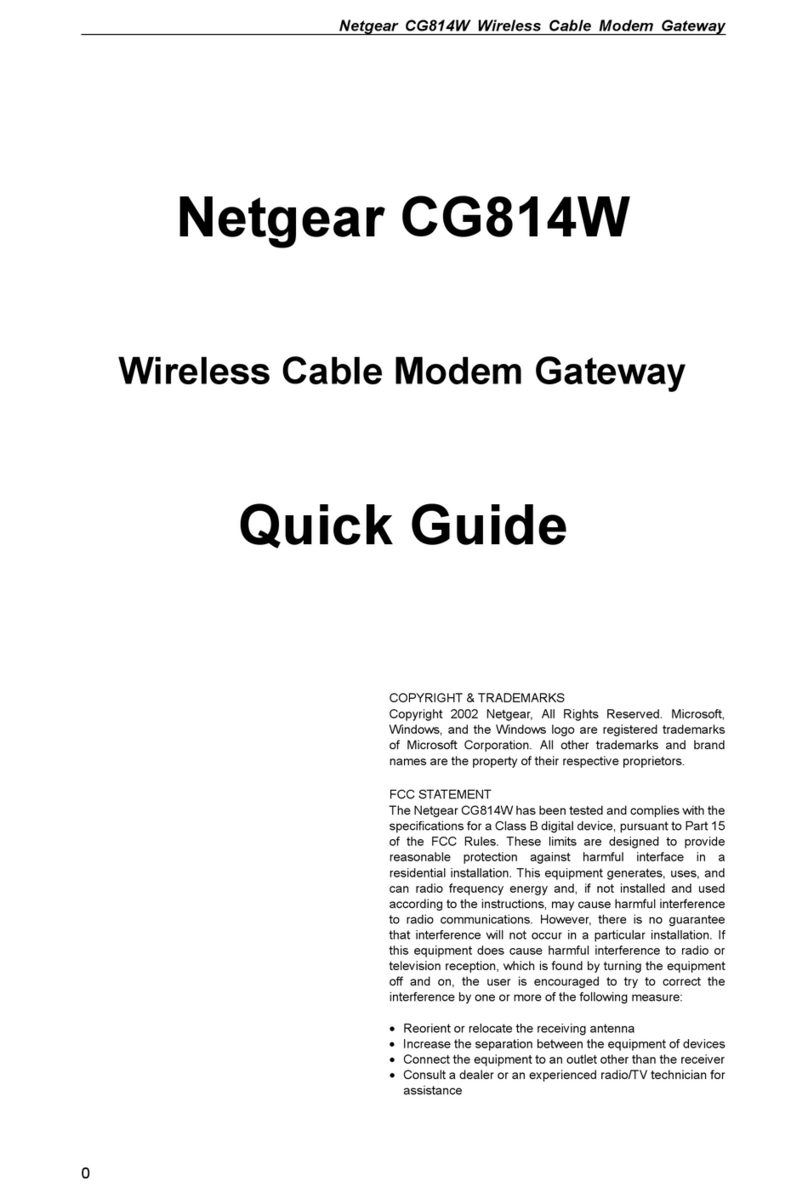
NETGEAR
NETGEAR CG814W quick guide

ZyXEL Communications
ZyXEL Communications ZYWALL USG 20W Brochure & specs
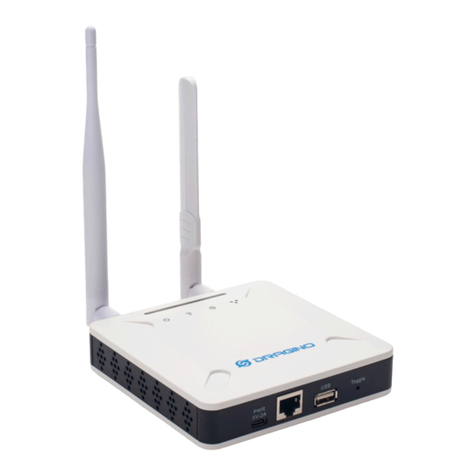
Dragino
Dragino LPS8v2 user manual

Emerson
Emerson Smart Wireless Gateway 1420 Quick installation guide
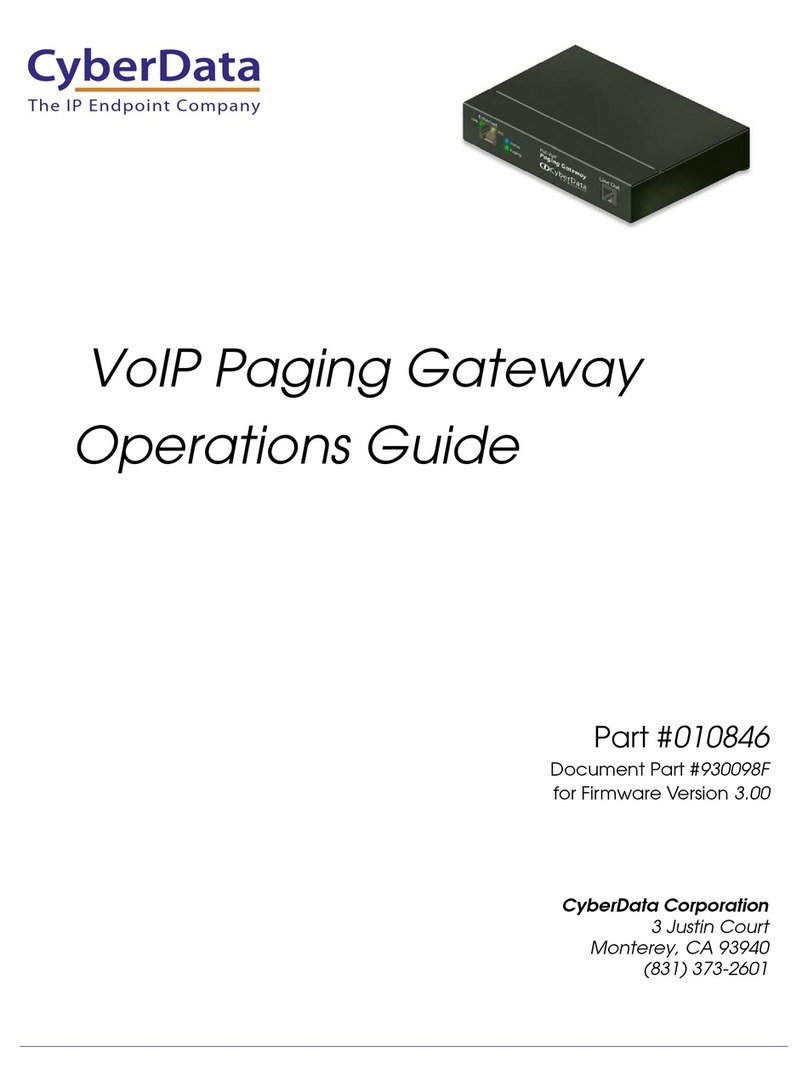
CyberData
CyberData SiP Compliant 010846 Operation guide
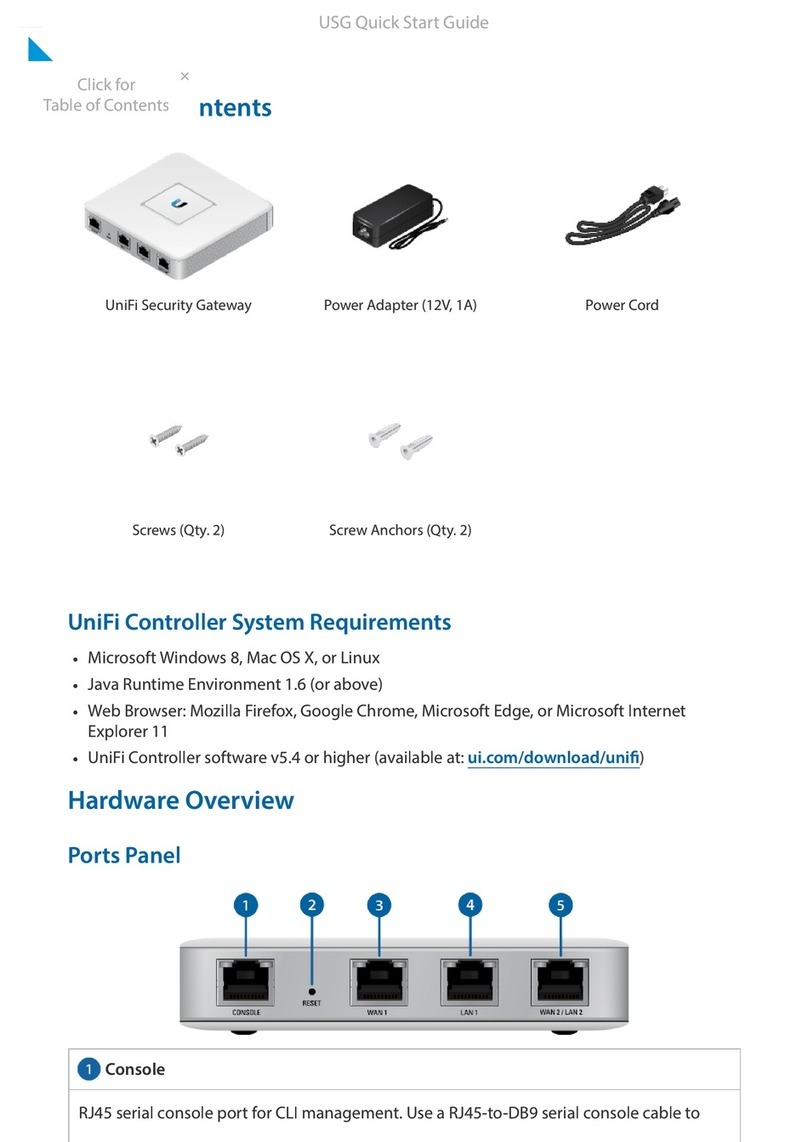
Ubiquiti
Ubiquiti UniFi USG quick start guide
